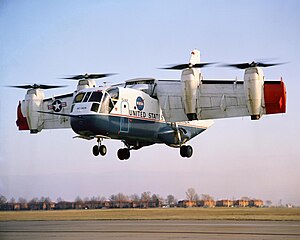LTV XC-142
| XC-142 | |
|---|---|
 |
|
| Role | Experimental V/STOL transport |
| Manufacturer | Ling-Temco-Vought (LTV) |
| First flight | 29 September 1964 |
| Primary user | NASA |
| Number built | 5 |
The Ling-Temco-Vought (LTV) XC-142 was a tri-service tiltwing experimental aircraft designed to investigate the operational suitability of vertical/short takeoff and landing (V/STOL) transports. An XC-142A first flew conventionally on 29 September 1964, and on 11 January 1965, it completed its first transitional flight by taking off vertically, changing to forward flight and finally landing vertically. Its service sponsors pulled out of the program one by one and it eventually ended due to a lack of interest after demonstrating its capabilities successfully.
In 1959 the United States Army, Navy and Air Force began work on the development of a prototype V/STOL aircraft that could augment helicopters in transport-type missions. Specifically they were interested in designs with longer range and higher speeds than existing helicopters, in order to support operations over longer distances, or in the case of the United States Marine Corps, from further offshore. On 27 January 1961, a series of DOD actions resulted in an agreement where all of the military arms would work on such a project under the overall leadership of the Navy's Bureau of Naval Weapons (BuWeps), the Tri-Service Assault Transport Program.
The original outline had been drawn up as a replacement for the Sikorsky HR2S, with a payload on the order of 10000 lb (4500 kg). BuWeps released a revised specification that specified the same payload, but extended the operational radius to 250 miles (400 km) and increased the cruising airspeed to 250–300 knots (460–560 km/h) and the maximum airspeed to 300–400 knots (560–740 km/h). However, for the Marine Corps mission, the requirement stated that the fuel load could be reduced so that the maximum gross weight would not exceed 35,000 pounds (16,000 kg), as long as a 100-nautical-mile (190 km) radius was maintained.
Vought responded with a proposal combining engineering from their own design arm, as well as Ryan and Hiller, who had more extensive helicopter experience. Their proposal won the design contest, and a contract for five prototypes was signed in early 1962 with first flight specified for July 1964. The design was initially known as the Vought-Ryan-Hiller XC-142, but when Vought became part of the LTV conglomerate this naming was dropped.
...
Wikipedia
